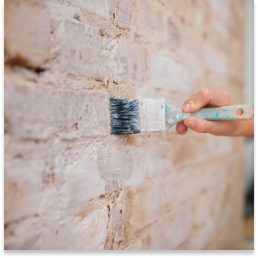Intro
There are many products available to protect exterior surfaces against weathering, ageing and cracking. You can use exterior paints such as Dulux’s White Masonry Paint to compliment or contrast your garden's colour scheme, or perhaps you want to retain a natural look for your outdoor space by using a varnish or oil, like Ronseal’s Natural Oak Decking Oil. Whatever exterior care product you choose, all options provide an extra layer of defence against the wind, sun, animals and other things that can invade the architecture and penetrate walls, helping to preserve the life of your exterior walls.
So, whether you are considering painting brick, metal or wood, there is an exterior paint that will work well for you. Sometimes a more specialist paint may be necessary, or perhaps paint bypassed entirely and a more natural oil or varnish considered. Whatever you need, this guide will break down each option to help you find the best fit for the job at hand.
What is the Best Outdoor Paint?
Choosing what exterior paint to use is largely dependent on the type of surface you are painting on. Most names are self-explanatory, for example, masonry paint is best for masonry, wood paint is best for wood… and metal paint is best for metal. Whatever the job, there are a few questions you should ask yourself before proceeding to help ensure you make the best decision.

Surface Conditions To Consider When Painting
The condition of the surface that you are planning to work on is pretty vital when deciding the type of paint you may need and the kind of preparation and product you will need beforehand (you may not need to do any at all). If the surface you’ll be painting is on the older side, you’ll need to make sure it is as clean and as dry as possible and in good repair. You’ll also want to remove as much dust, mould, algae and moss as you can from surfaces like wood and brick. You can do this in a couple of ways:
- For algae on brick surfaces, you can use products such as our algae cleaner.
- For mould on wood surfaces, you can tackle it DIY-style. There are many helpful resources to guide you through this process online, including This Old House's. Regardless of the method, always ensure you’re wearing the correct protective gear!
- For dust, simply wipe down the surface with a barely damp microfibre cloth. If the surface is wood, make sure you quickly dry the area to prevent mould growth.
Picking The Right Paint Finish and Colour
Make sure you’re taking time to consider what you want the final result to look like, as picking out the correct external care product will be vital in achieving this goal.
Colour: You can opt for a bold shade to add some brightness to your outdoor space, or a softer, more muted choice that still adds a pop of colour, such as this delicate magnolia shade from Dulux. Perhaps you want something that can blend in with its surroundings seamlessly and expertly conceal the weathering of an older surface, such as Blackfriar’s tile red shade of masonry paint, perfect for use on bricks and tiles.
Surface: Of course, consider the surface you’ll be painting; if you want to enhance the natural look of a material, such as a wooden fence, simply staining it can help to bring out its natural features whilst still protecting it from the elements. Products such as Ronseal’s Satin Woodstain are perfect for this job, not only maintaining the look of the wood, but preventing the surface from cracking, blistering and peeling throughout its extended life span.
Finish: With exterior paints available in different styles and textures, it's worth having a think about what you want the final finish to be.
- Matt Finish: Paints such as this will produce a flat, non-reflective finish and help to disguise bumps and uneven surfaces.
- Satin Finish: Also known as silk, this kind of finish offers a low and refined sheen, offering a happy compromise between matt and gloss.
- Gloss Finish: Gloss finishes provide the highest level of sheen and are also the most durable choice on offer. Due to its longevity and hard-wearing characteristics, this paint is ideal for areas that will get bumped or scuffed regularly, such as external doors.
- Smooth Finish: This finish is only available for masonry paints. It gives the surface a velvety, smooth finish and is very quick and easy to apply.
- Textured Finish: Also known as fine-textured finish, this paint is used to give masonry long-lasting coverage that helps to conceal uneven surfaces and smaller cracks.
- Hammered Effect Finish: This paint is exclusively made for metal paints, with the aim of creating the effect of the surface looking distressed or textured. Some hammered effect metal paints can replicate the look of cast iron, or even galvanised metal, making it perfect for upcycling projects outside.
How much time is available to complete the project?
If you’re limited for time, do not worry! We offer a range of quick-drying options to ensure whatever job at hand gets completed as quickly as possible, like our Dulux Quick Dry Satin Paint that is touch-dry in just 1-2 hours.
Types of Exterior Protection
As briefly mentioned before, there are three main types of material the products can be used for: masonry, metal and wood. Each paint has slightly different properties that work best with the surface in question, so it can pay off to remember your options:
- Metal exterior paint
- Masonry exterior paint
- Exterior woodcare, which can come in the form of (1) exterior wood paint (2) exterior wood oil (3) exterior wood stain and (4) exterior wood varnish.
Most paints also require a layer of undercoat or primer before application to ensure the paint goes on smoothly.
Let’s look into each option in more detail…











